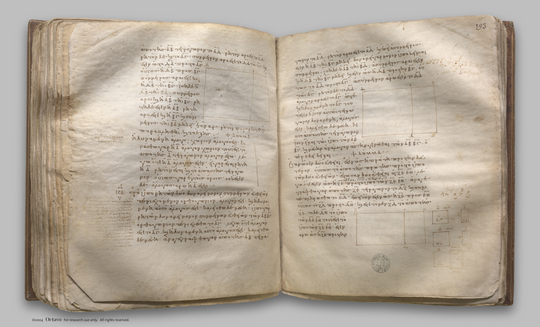index prev next | digilib folio 197

The rectangle contained by rational straight lines commensurable in square only is irrational, and the side of the square equal to it is irrational.
| Τὸ ὑπὸ ῥητῶν δυνάμει μόνον συμμέτρων εὐθειῶν περιεχόμενον ὀρθογώνιον ἄλογόν ἐστιν, καὶ ἡ δυναμένη αὐτὸ ἄλογός ἐστιν, καλείσθω δὲ μέση. Ὑπὸ γὰρ ῥητῶν δυνάμει μόνον συμμέτρων εὐθειῶν τῶν ΑΒ, ΒΓ ὀρθογώνιον περιεχέσθω τὸ ΑΓ: λέγω, ὅτι ἄλογόν ἐστι τὸ ΑΓ, καὶ ἡ δυναμένη αὐτὸ ἄλογός ἐστιν, καλείσθω δὲ μέση. Ἀναγεγράφθω γὰρ ἀπὸ τῆς ΑΒ τετράγωνον τὸ ΑΔ: ῥητὸν ἄρα ἐστὶ τὸ ΑΔ. καὶ ἐπεὶ ἀσύμμετρός ἐστιν ἡ ΑΒ τῇ ΒΓ μήκει: δυνάμει γὰρ μόνον ὑπόκεινται σύμμετροι: ἴση δὲ ἡ ΑΒ τῇ ΒΔ, ἀσύμμετρος ἄρα ἐστὶ καὶ ἡ ΔΒ τῇ ΒΓ μήκει. καί ἐστιν ὡς ἡ ΔΒ πρὸς τὴν ΒΓ, οὕτως τὸ ΑΔ πρὸς τὸ ΑΓ: ἀσύμμετρον ἄρα [ ἐστὶ ] τὸ ΔΑ τῷ ΑΓ. ῥητὸν δὲ τὸ ΔΑ: ἄλογον ἄρα ἐστὶ τὸ ΑΓ: ὥστε καὶ ἡ δυναμένη τὸ ΑΓ [ τουτέστιν ἡ ἴσον αὐτῷ τετράγωνον δυναμένη ] ἄλογός ἐστιν, καλείσθω δὲ μέση: ὅπερ ἔδει δεῖξαι. Λῆμμα Ἐὰν ὦσι δύο εὐθεῖαι, ἔστιν ὡς ἡ πρώτη πρὸς τὴν δευτέραν, οὕτως τὸ ἀπὸ τῆς πρώτης πρὸς τὸ ὑπὸ τῶν δύο εὐθειῶν. Ἔστωσαν δύο εὐθεῖαι αἱ ΖΕ, ΕΗ. λέγω, ὅτι ἐστὶν ὡς ἡ ΖΕ πρὸς τὴν ΕΗ, οὕτως τὸ ἀπὸ τῆς ΖΕ πρὸς τὸ ὑπὸ τῶν ΖΕ, ΕΗ. Ἀναγεγράφθω γὰρ ἀπὸ τῆς ΖΕ τετράγωνον τὸ ΔΖ, καὶ συμπεπληρώσθω τὸ ΗΔ. ἐπεὶ οὖν ἐστιν ὡς ἡ ΖΕ πρὸς τὴν ΕΗ, οὕτως τὸ ΖΔ πρὸς τὸ ΔΗ, καί ἐστι τὸ μὲν ΖΔ τὸ ἀπὸ τῆς ΖΕ, τὸ δὲ ΔΗ τὸ ὑπὸ τῶν ΔΕ, ΕΗ, τουτέστι τὸ ὑπὸ τῶν ΖΕ, ΕΗ, ἔστιν ἄρα ὡς ἡ ΖΕ τὴν ΕΗ, οὕτως τὸ ἀπὸ τῆς ΖΕ πρὸς τὸ ὑπὸ τῶν ΖΕ, ΕΗ. ὁμοίως δὲ καὶ ὡς τὸ ὑπὸ τῶν ΗΕ, ΕΖ πρὸς τὸ ἀπὸ τῆς ΕΖ, τουτέστιν ὡς τὸ ΗΔ πρὸς τὸ ΖΔ, οὕτως ἡ ΗΕ πρὸς τὴν ΕΖ: ὅπερ ἔδει δεῖξαι. | The rectangle contained by rational straight lines commensurable in square only is irrational, and the side of the square equal to it is irrational. Let the latter be called medial. For let the rectangle AC be contained by the rational straight lines AB, BC commensurable in square only; I say that AC is irrational, and the side of the square equal to it is irrational; and let the latter be called medial. For on AB let the square AD be described; therefore AD is rational. [X. Def. 4] And, since AB is incommensurable in length with BC, for by hypothesis they are commensurable in square only, while AB is equal to BD, therefore DB is also incommensurable in length with BC. And, as DB is to BC, so is AD to AC; [VI. 1] therefore DA is incommensurable with AC. [X. 11] But DA is rational; therefore AC is irrational, so that the side of the square equal to AC is also irrational. [X. Def. 4] And let the latter be called medial. Q. E. D. LEMMA. If there be two straight lines, then, as the first is to the second, so is the square on the first to the rectangle contained by the two straight lines. Let FE, EG be two straight lines. I say that, as FE is to EG, so is the square on FE to the rectangle FE, EG. For on FE let the square DF be described, and let GD be completed. Since then, as FE is to EG, so is FD to DG, [VI. 1] and FD is the square on FE, and DG the rectangle DE, EG, that is, the rectangle FE, EG, therefore, as FE is to EG, so is the square on FE to the rectangle FE, EG. |